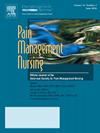Decreased Opioid Utilization with Lidocaine Topical System 1.8% Compared to Lidocaine 5% Patch: A retrospective Claims Analysis
IF 1.6
4区 医学
Q2 NURSING
引用次数: 0
Abstract
Aim/Design
Using retrospective claims data from Optum's de-identified Normative Health Informatics database (5/2018 to 9/2023), we evaluated the impact of different lidocaine topical systems on the utilization of opioids in patients with neuropathic pain (post-herpetic neuralgia, diabetic peripheral neuropathy or lower back pain).
Results
The final analysis included 6,014 patients taking opioids and either lidocaine topical system 1.8% or lidocaine patch 5% as index treatment. 51.9% of lidocaine topical system patients experienced either a decrease or discontinuation of opioid use in the post-prescription period compared to 45.5% of lidocaine patch patients (Chi-square test, p=0.021). Lidocaine topical system patients had a non-significant change in pre- versus post-prescription median Morphine Milligram Equivalents (MME) (3.1% increase, Wilcoxon signed rank test, p=0.146); while lidocaine patch patients experienced a significant increase in pre-versus post-prescription median MME (42.9% increase, Wilcoxon signed rank test, p<0.001). Based on these data, lidocaine topical system usage may be associated with reduced opioid utilization compared with lidocaine patch.
Nursing Implications
Nurses are at the forefront of patient care and play an important role in helping patients to reduce opioid utilization. Thus, it is crucial for them to have the most up-to-date information on non-opioid treatment options that may optimize pain management and reduce unnecessary opioid usage.
Implications for future research
Further analysis of the data is needed to understand the patient subpopulations that are most impacted.
求助全文
约1分钟内获得全文
求助全文
来源期刊

Pain Management Nursing
医学-护理
CiteScore
3.00
自引率
5.90%
发文量
187
审稿时长
>12 weeks
期刊介绍:
This peer-reviewed journal offers a unique focus on the realm of pain management as it applies to nursing. Original and review articles from experts in the field offer key insights in the areas of clinical practice, advocacy, education, administration, and research. Additional features include practice guidelines and pharmacology updates.
 求助内容:
求助内容: 应助结果提醒方式:
应助结果提醒方式:


